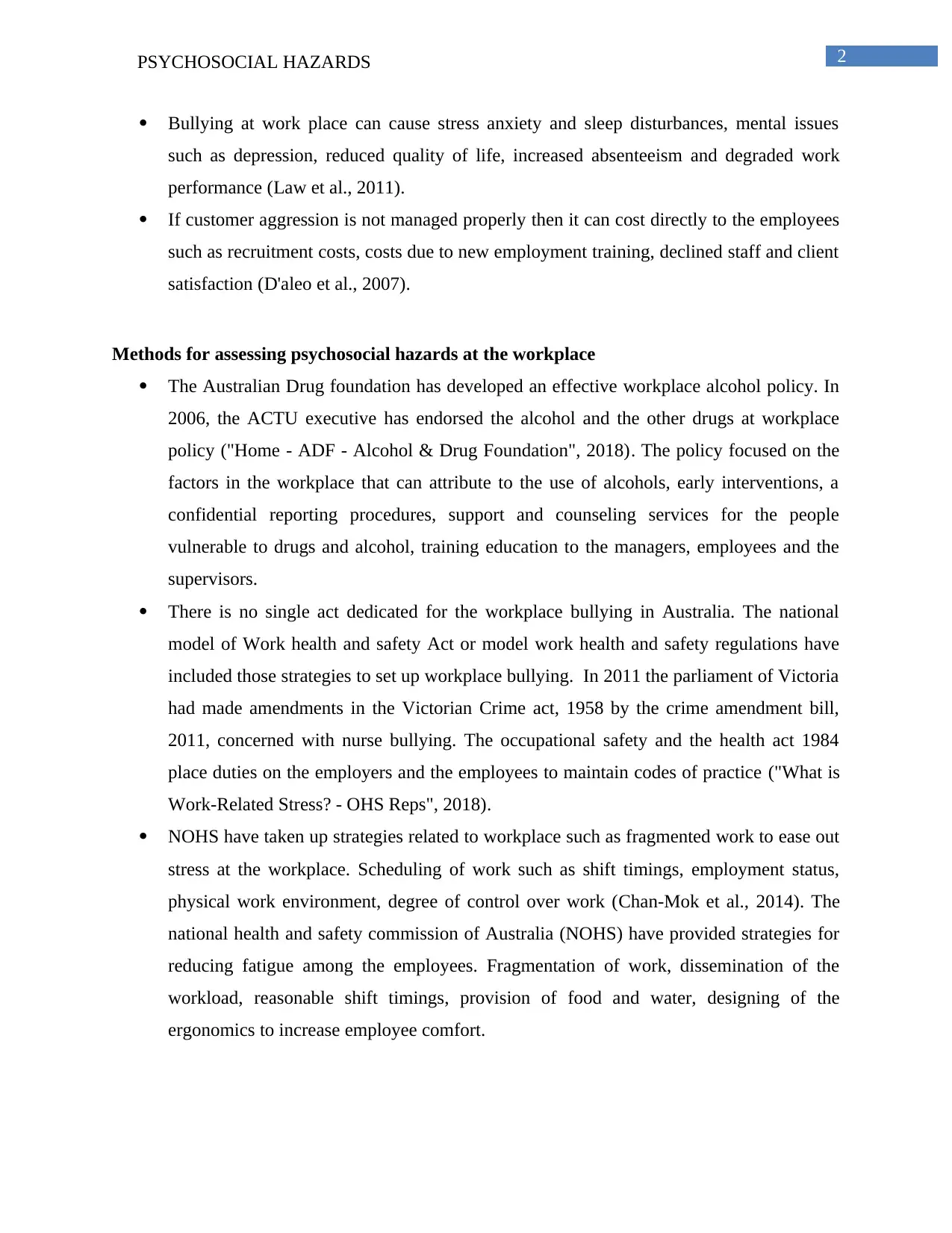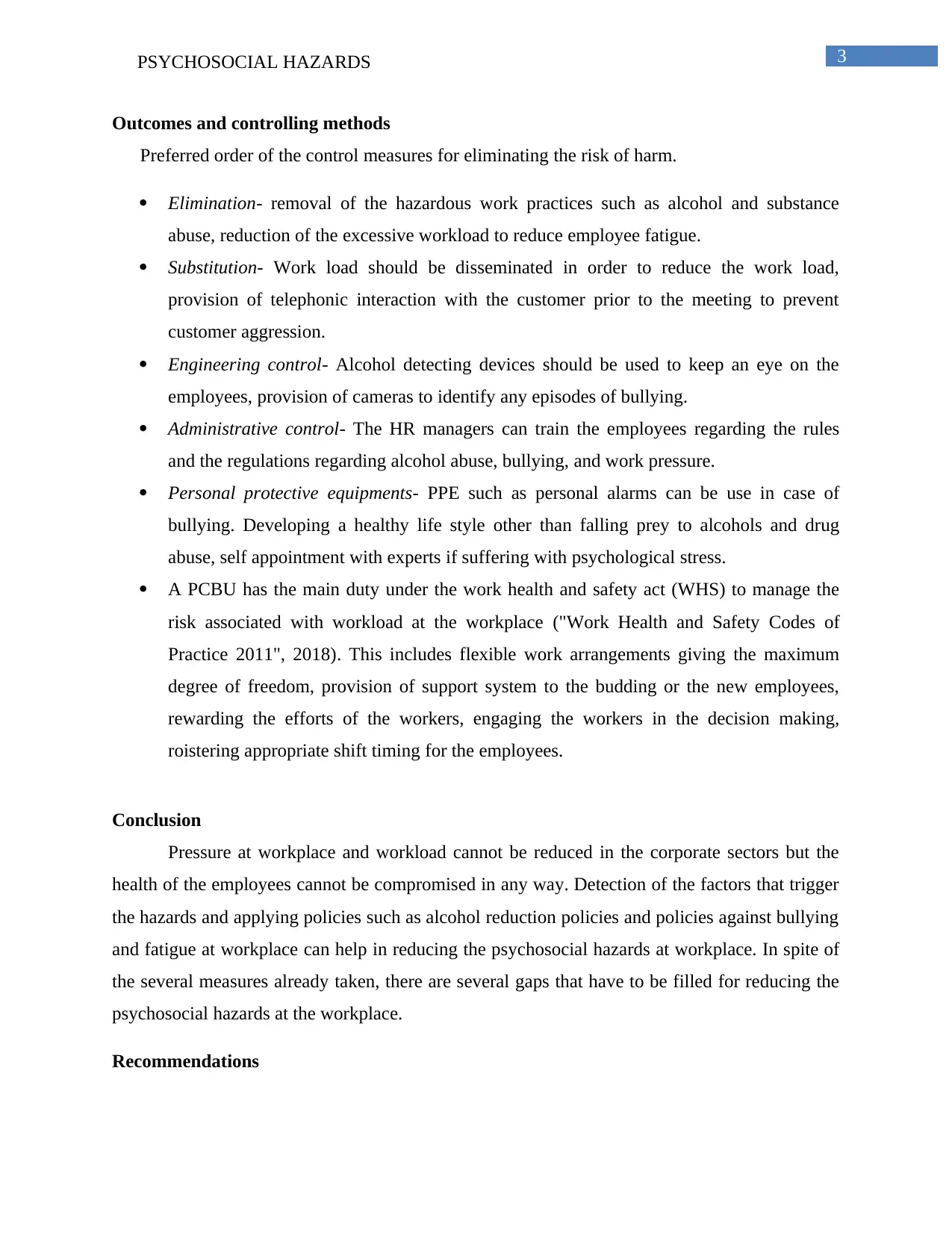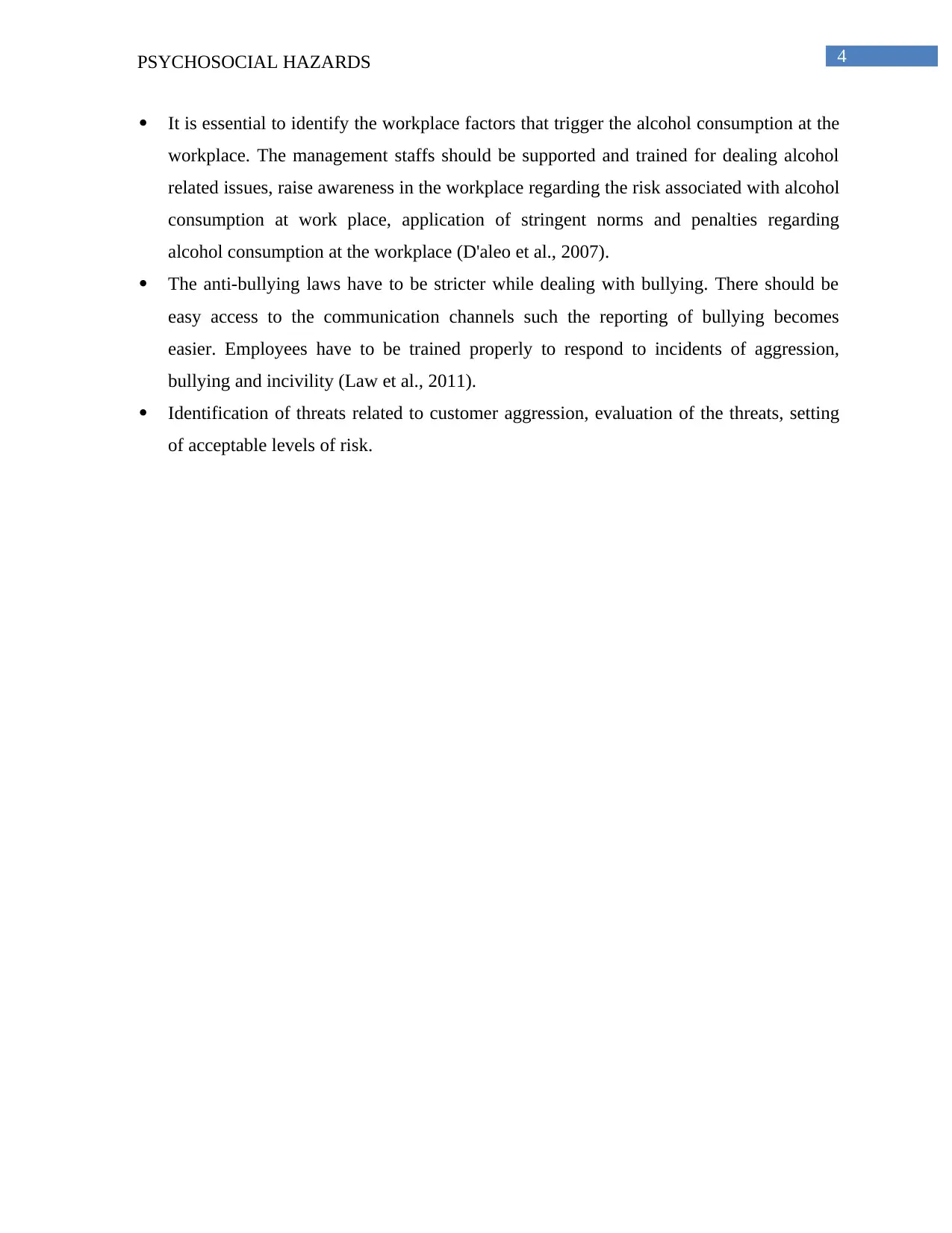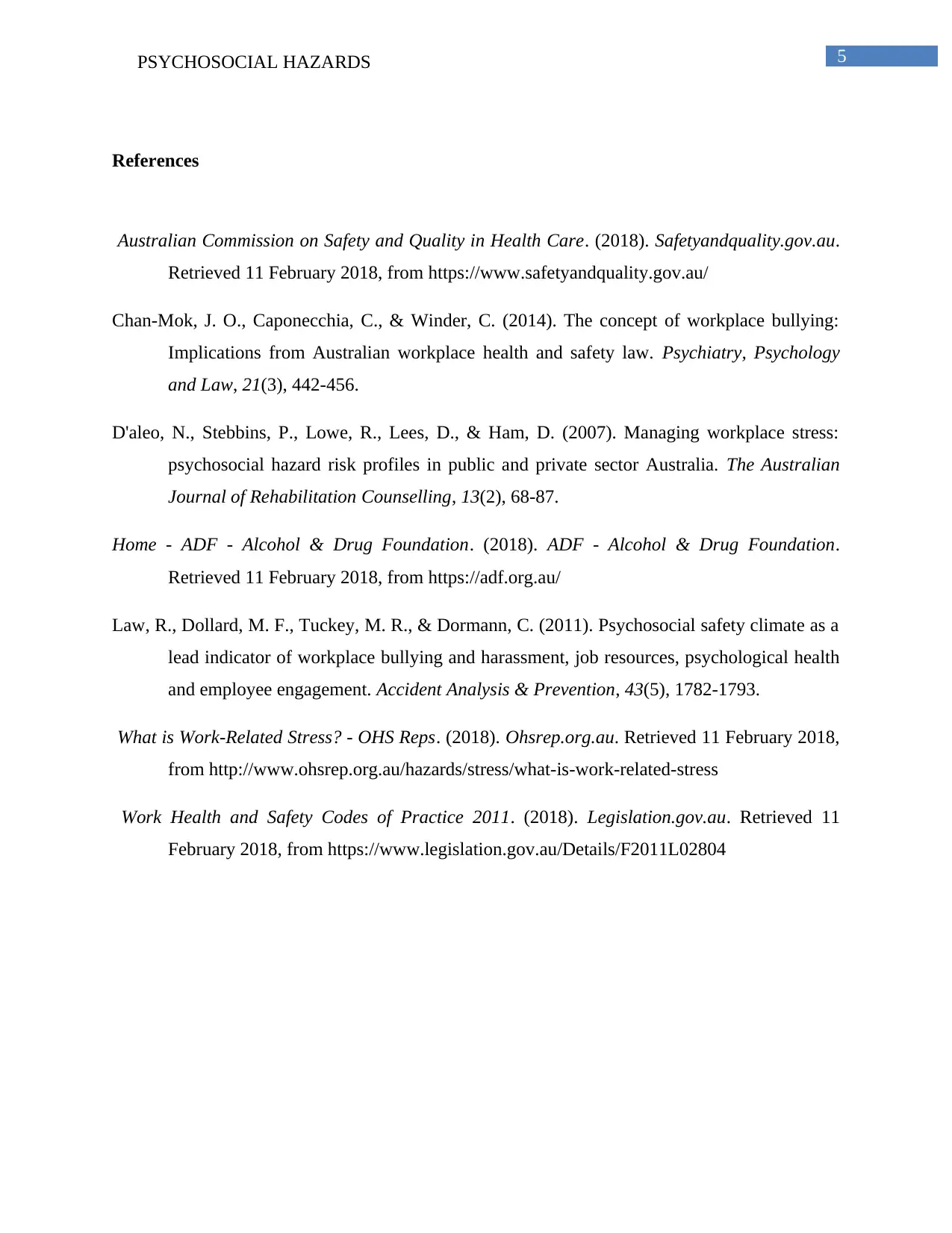Psychosocial Hazards at Workplace: Health Impact, Risk Assessment and Control Measures
VerifiedAdded on 2023/06/15
|6
|1509
|308
AI Summary
This briefing note discusses psychosocial hazards at workplace, their health impact, risk assessment, and control measures. It covers alcohol, bullying, and customer aggression at workplace, their adverse effects, and methods for assessing and controlling these hazards. The note also provides recommendations for reducing psychosocial hazards at workplace.
Contribute Materials
Your contribution can guide someone’s learning journey. Share your
documents today.

Running head: PSYCHOSOCIAL HAZARDS
PSYCHOSOCIAL HAZARDS
Name of the Student
Name of the university
Author’s note
PSYCHOSOCIAL HAZARDS
Name of the Student
Name of the university
Author’s note
Secure Best Marks with AI Grader
Need help grading? Try our AI Grader for instant feedback on your assignments.

1PSYCHOSOCIAL HAZARDS
Introduction
This briefing note will be discussing about the psychosocial hazards taking place at work
place, the health impact of exposure to the identified hazards, the potential outcomes of the risk
assessment hazards and the various measures for controlling the risks. Work is beneficial to
mental well state and personal well being of a person. It provides a sense of identity in a person.
7500 Australians had been suffering from work related psychological disorders equating to
around 6% of the workers compensation claims. About $480 millions of Australian workers are
paid compensation for the work related mental disorders ("Australian Commission on Safety and
Quality in Health Care", 2018). Most common types of psychosocial hazards noticed are alcohol
in the work place, driver fatigue, customer aggression, work related mental disorders, remote or
isolated work.
Issue
Alcohol in the workplace- about 15 % of the work place injuries in Australia have been
attributed by the drug and substance abuse. And the economic cost due to alcohol use in
Australia can be estimated about $4.5 billion a year contributing to the largest proportion
to cost ("Australian Commission on Safety and Quality in Health Care", 2018).
Work place bullying- Workers in Australia had been facing with psychological distress
due to work place bullying. Reports showing 154% higher loss in performance at work.
12% more sick days per month have been obtained by the employers ("What is Work-
Related Stress? - OHS Reps", 2018).
Customer aggression-Customer aggression towards an employee can create a
frightening, intimidating situation.
Adverse effects
Adverse physical effects such as liver cirrhosis, cancer, cardiovascular diseases, poor
mental health, loss of job due to dismissal from the workplace and violence are the
possible adverse effects of the alcohol consumption at the workplace (D'aleo et al., 2007).
Introduction
This briefing note will be discussing about the psychosocial hazards taking place at work
place, the health impact of exposure to the identified hazards, the potential outcomes of the risk
assessment hazards and the various measures for controlling the risks. Work is beneficial to
mental well state and personal well being of a person. It provides a sense of identity in a person.
7500 Australians had been suffering from work related psychological disorders equating to
around 6% of the workers compensation claims. About $480 millions of Australian workers are
paid compensation for the work related mental disorders ("Australian Commission on Safety and
Quality in Health Care", 2018). Most common types of psychosocial hazards noticed are alcohol
in the work place, driver fatigue, customer aggression, work related mental disorders, remote or
isolated work.
Issue
Alcohol in the workplace- about 15 % of the work place injuries in Australia have been
attributed by the drug and substance abuse. And the economic cost due to alcohol use in
Australia can be estimated about $4.5 billion a year contributing to the largest proportion
to cost ("Australian Commission on Safety and Quality in Health Care", 2018).
Work place bullying- Workers in Australia had been facing with psychological distress
due to work place bullying. Reports showing 154% higher loss in performance at work.
12% more sick days per month have been obtained by the employers ("What is Work-
Related Stress? - OHS Reps", 2018).
Customer aggression-Customer aggression towards an employee can create a
frightening, intimidating situation.
Adverse effects
Adverse physical effects such as liver cirrhosis, cancer, cardiovascular diseases, poor
mental health, loss of job due to dismissal from the workplace and violence are the
possible adverse effects of the alcohol consumption at the workplace (D'aleo et al., 2007).

2PSYCHOSOCIAL HAZARDS
Bullying at work place can cause stress anxiety and sleep disturbances, mental issues
such as depression, reduced quality of life, increased absenteeism and degraded work
performance (Law et al., 2011).
If customer aggression is not managed properly then it can cost directly to the employees
such as recruitment costs, costs due to new employment training, declined staff and client
satisfaction (D'aleo et al., 2007).
Methods for assessing psychosocial hazards at the workplace
The Australian Drug foundation has developed an effective workplace alcohol policy. In
2006, the ACTU executive has endorsed the alcohol and the other drugs at workplace
policy ("Home - ADF - Alcohol & Drug Foundation", 2018). The policy focused on the
factors in the workplace that can attribute to the use of alcohols, early interventions, a
confidential reporting procedures, support and counseling services for the people
vulnerable to drugs and alcohol, training education to the managers, employees and the
supervisors.
There is no single act dedicated for the workplace bullying in Australia. The national
model of Work health and safety Act or model work health and safety regulations have
included those strategies to set up workplace bullying. In 2011 the parliament of Victoria
had made amendments in the Victorian Crime act, 1958 by the crime amendment bill,
2011, concerned with nurse bullying. The occupational safety and the health act 1984
place duties on the employers and the employees to maintain codes of practice ("What is
Work-Related Stress? - OHS Reps", 2018).
NOHS have taken up strategies related to workplace such as fragmented work to ease out
stress at the workplace. Scheduling of work such as shift timings, employment status,
physical work environment, degree of control over work (Chan-Mok et al., 2014). The
national health and safety commission of Australia (NOHS) have provided strategies for
reducing fatigue among the employees. Fragmentation of work, dissemination of the
workload, reasonable shift timings, provision of food and water, designing of the
ergonomics to increase employee comfort.
Bullying at work place can cause stress anxiety and sleep disturbances, mental issues
such as depression, reduced quality of life, increased absenteeism and degraded work
performance (Law et al., 2011).
If customer aggression is not managed properly then it can cost directly to the employees
such as recruitment costs, costs due to new employment training, declined staff and client
satisfaction (D'aleo et al., 2007).
Methods for assessing psychosocial hazards at the workplace
The Australian Drug foundation has developed an effective workplace alcohol policy. In
2006, the ACTU executive has endorsed the alcohol and the other drugs at workplace
policy ("Home - ADF - Alcohol & Drug Foundation", 2018). The policy focused on the
factors in the workplace that can attribute to the use of alcohols, early interventions, a
confidential reporting procedures, support and counseling services for the people
vulnerable to drugs and alcohol, training education to the managers, employees and the
supervisors.
There is no single act dedicated for the workplace bullying in Australia. The national
model of Work health and safety Act or model work health and safety regulations have
included those strategies to set up workplace bullying. In 2011 the parliament of Victoria
had made amendments in the Victorian Crime act, 1958 by the crime amendment bill,
2011, concerned with nurse bullying. The occupational safety and the health act 1984
place duties on the employers and the employees to maintain codes of practice ("What is
Work-Related Stress? - OHS Reps", 2018).
NOHS have taken up strategies related to workplace such as fragmented work to ease out
stress at the workplace. Scheduling of work such as shift timings, employment status,
physical work environment, degree of control over work (Chan-Mok et al., 2014). The
national health and safety commission of Australia (NOHS) have provided strategies for
reducing fatigue among the employees. Fragmentation of work, dissemination of the
workload, reasonable shift timings, provision of food and water, designing of the
ergonomics to increase employee comfort.

3PSYCHOSOCIAL HAZARDS
Outcomes and controlling methods
Preferred order of the control measures for eliminating the risk of harm.
Elimination- removal of the hazardous work practices such as alcohol and substance
abuse, reduction of the excessive workload to reduce employee fatigue.
Substitution- Work load should be disseminated in order to reduce the work load,
provision of telephonic interaction with the customer prior to the meeting to prevent
customer aggression.
Engineering control- Alcohol detecting devices should be used to keep an eye on the
employees, provision of cameras to identify any episodes of bullying.
Administrative control- The HR managers can train the employees regarding the rules
and the regulations regarding alcohol abuse, bullying, and work pressure.
Personal protective equipments- PPE such as personal alarms can be use in case of
bullying. Developing a healthy life style other than falling prey to alcohols and drug
abuse, self appointment with experts if suffering with psychological stress.
A PCBU has the main duty under the work health and safety act (WHS) to manage the
risk associated with workload at the workplace ("Work Health and Safety Codes of
Practice 2011", 2018). This includes flexible work arrangements giving the maximum
degree of freedom, provision of support system to the budding or the new employees,
rewarding the efforts of the workers, engaging the workers in the decision making,
roistering appropriate shift timing for the employees.
Conclusion
Pressure at workplace and workload cannot be reduced in the corporate sectors but the
health of the employees cannot be compromised in any way. Detection of the factors that trigger
the hazards and applying policies such as alcohol reduction policies and policies against bullying
and fatigue at workplace can help in reducing the psychosocial hazards at workplace. In spite of
the several measures already taken, there are several gaps that have to be filled for reducing the
psychosocial hazards at the workplace.
Recommendations
Outcomes and controlling methods
Preferred order of the control measures for eliminating the risk of harm.
Elimination- removal of the hazardous work practices such as alcohol and substance
abuse, reduction of the excessive workload to reduce employee fatigue.
Substitution- Work load should be disseminated in order to reduce the work load,
provision of telephonic interaction with the customer prior to the meeting to prevent
customer aggression.
Engineering control- Alcohol detecting devices should be used to keep an eye on the
employees, provision of cameras to identify any episodes of bullying.
Administrative control- The HR managers can train the employees regarding the rules
and the regulations regarding alcohol abuse, bullying, and work pressure.
Personal protective equipments- PPE such as personal alarms can be use in case of
bullying. Developing a healthy life style other than falling prey to alcohols and drug
abuse, self appointment with experts if suffering with psychological stress.
A PCBU has the main duty under the work health and safety act (WHS) to manage the
risk associated with workload at the workplace ("Work Health and Safety Codes of
Practice 2011", 2018). This includes flexible work arrangements giving the maximum
degree of freedom, provision of support system to the budding or the new employees,
rewarding the efforts of the workers, engaging the workers in the decision making,
roistering appropriate shift timing for the employees.
Conclusion
Pressure at workplace and workload cannot be reduced in the corporate sectors but the
health of the employees cannot be compromised in any way. Detection of the factors that trigger
the hazards and applying policies such as alcohol reduction policies and policies against bullying
and fatigue at workplace can help in reducing the psychosocial hazards at workplace. In spite of
the several measures already taken, there are several gaps that have to be filled for reducing the
psychosocial hazards at the workplace.
Recommendations
Secure Best Marks with AI Grader
Need help grading? Try our AI Grader for instant feedback on your assignments.

4PSYCHOSOCIAL HAZARDS
It is essential to identify the workplace factors that trigger the alcohol consumption at the
workplace. The management staffs should be supported and trained for dealing alcohol
related issues, raise awareness in the workplace regarding the risk associated with alcohol
consumption at work place, application of stringent norms and penalties regarding
alcohol consumption at the workplace (D'aleo et al., 2007).
The anti-bullying laws have to be stricter while dealing with bullying. There should be
easy access to the communication channels such the reporting of bullying becomes
easier. Employees have to be trained properly to respond to incidents of aggression,
bullying and incivility (Law et al., 2011).
Identification of threats related to customer aggression, evaluation of the threats, setting
of acceptable levels of risk.
It is essential to identify the workplace factors that trigger the alcohol consumption at the
workplace. The management staffs should be supported and trained for dealing alcohol
related issues, raise awareness in the workplace regarding the risk associated with alcohol
consumption at work place, application of stringent norms and penalties regarding
alcohol consumption at the workplace (D'aleo et al., 2007).
The anti-bullying laws have to be stricter while dealing with bullying. There should be
easy access to the communication channels such the reporting of bullying becomes
easier. Employees have to be trained properly to respond to incidents of aggression,
bullying and incivility (Law et al., 2011).
Identification of threats related to customer aggression, evaluation of the threats, setting
of acceptable levels of risk.

5PSYCHOSOCIAL HAZARDS
References
Australian Commission on Safety and Quality in Health Care. (2018). Safetyandquality.gov.au.
Retrieved 11 February 2018, from https://www.safetyandquality.gov.au/
Chan-Mok, J. O., Caponecchia, C., & Winder, C. (2014). The concept of workplace bullying:
Implications from Australian workplace health and safety law. Psychiatry, Psychology
and Law, 21(3), 442-456.
D'aleo, N., Stebbins, P., Lowe, R., Lees, D., & Ham, D. (2007). Managing workplace stress:
psychosocial hazard risk profiles in public and private sector Australia. The Australian
Journal of Rehabilitation Counselling, 13(2), 68-87.
Home - ADF - Alcohol & Drug Foundation. (2018). ADF - Alcohol & Drug Foundation.
Retrieved 11 February 2018, from https://adf.org.au/
Law, R., Dollard, M. F., Tuckey, M. R., & Dormann, C. (2011). Psychosocial safety climate as a
lead indicator of workplace bullying and harassment, job resources, psychological health
and employee engagement. Accident Analysis & Prevention, 43(5), 1782-1793.
What is Work-Related Stress? - OHS Reps. (2018). Ohsrep.org.au. Retrieved 11 February 2018,
from http://www.ohsrep.org.au/hazards/stress/what-is-work-related-stress
Work Health and Safety Codes of Practice 2011. (2018). Legislation.gov.au. Retrieved 11
February 2018, from https://www.legislation.gov.au/Details/F2011L02804
References
Australian Commission on Safety and Quality in Health Care. (2018). Safetyandquality.gov.au.
Retrieved 11 February 2018, from https://www.safetyandquality.gov.au/
Chan-Mok, J. O., Caponecchia, C., & Winder, C. (2014). The concept of workplace bullying:
Implications from Australian workplace health and safety law. Psychiatry, Psychology
and Law, 21(3), 442-456.
D'aleo, N., Stebbins, P., Lowe, R., Lees, D., & Ham, D. (2007). Managing workplace stress:
psychosocial hazard risk profiles in public and private sector Australia. The Australian
Journal of Rehabilitation Counselling, 13(2), 68-87.
Home - ADF - Alcohol & Drug Foundation. (2018). ADF - Alcohol & Drug Foundation.
Retrieved 11 February 2018, from https://adf.org.au/
Law, R., Dollard, M. F., Tuckey, M. R., & Dormann, C. (2011). Psychosocial safety climate as a
lead indicator of workplace bullying and harassment, job resources, psychological health
and employee engagement. Accident Analysis & Prevention, 43(5), 1782-1793.
What is Work-Related Stress? - OHS Reps. (2018). Ohsrep.org.au. Retrieved 11 February 2018,
from http://www.ohsrep.org.au/hazards/stress/what-is-work-related-stress
Work Health and Safety Codes of Practice 2011. (2018). Legislation.gov.au. Retrieved 11
February 2018, from https://www.legislation.gov.au/Details/F2011L02804
1 out of 6
Related Documents
Your All-in-One AI-Powered Toolkit for Academic Success.
+13062052269
info@desklib.com
Available 24*7 on WhatsApp / Email
![[object Object]](/_next/static/media/star-bottom.7253800d.svg)
Unlock your academic potential
© 2024 | Zucol Services PVT LTD | All rights reserved.




